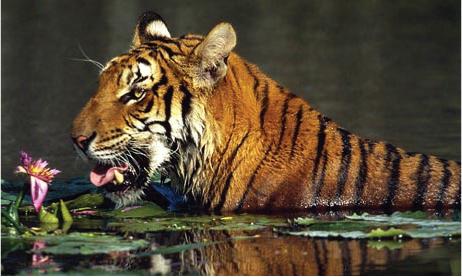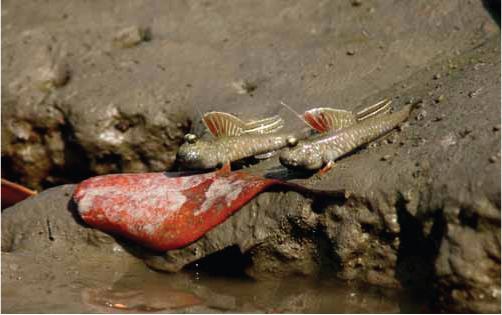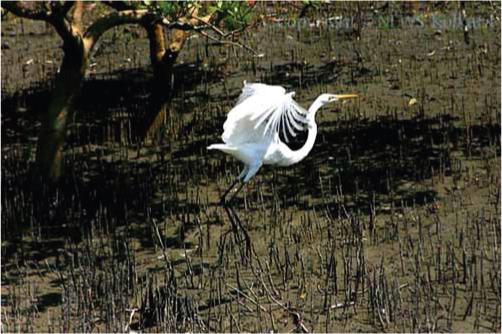Contribute
| Travelogue: Journey To The Sundarban Jungle |
Devika Banerjee
07/06/2011
The sun’s rays are luminous and the azure blue sky is scattered with puffs of white clouds. The iridescent waves are rolling up against the sides of the safari boat. We are peacefully sitting on the boat, sipping fresh green coconut juice and eating the thin layer of sweet flesh inside. The boat is flowing in between the land, sheltered by the dense, green forest that lies at the mouth of the Ganges River. We have not seen much wildlife yet, but our hopes are high. All of a sudden, the boat comes to a halt. We stand up and intently search the shores with our binoculars. The tour guide points towards the shore as we draw closer to the banks. There, imprinted in front of our eyes, lies the outline of a great paw print in the dark mud, the paw print of the most famous resident of these jungles: the Bengal tiger.
We are on a thrilling river expedition through the largest delta in the world, embedded with clusters of islands amidst the emerald waters, known as the Sundarbans, “the beautiful jungle.†For miles and miles, the lofty treetops of the forests form an unbroken canopy. This dense mangrove forest spreads across parts of Bangladesh and West Bengal, India. These evergreen mangroves pulsate with an abundance of life, camouflaging the animals hidden within; its beauty lies in its unique natural surroundings. Since the marshy soil is poor in oxygen, these trees have evolved “breathing roots†which stick upwards like spikes, to ensure adequate supply of oxygen. Thousands of tortuous creeks, streams, and rivers snake past these islands and enhance their charm. These jungles are natural habitats of many endangered species and home to approximately 70 of the world’s endangered Bengal Tigers.
Wild life presents many a spectacle in these jungles. While floating on the river, our eyes catch a swift glance of the river dolphins leaping from the water and a lethargic crocodile basking on the river banks, caked with dry mud. On the wet mud, the slimy mudskippers scamper and slip into their holes while the Great White Egrets soar above us. We gaze at a herd of spotted deer prancing about and the monkeys swinging from the branches. It would be a dream to ever come across the fierce, yet majestic Bengal Tiger, with its elegant striped body, peeking through the mighty jungle or taking a dip in the cool river.
From a very young age, I have always been captivated by tigers. I remember watching Mogley in Walt Disney’s The Jungle Book, living in these very jungles along with his animal friends. Here in the Sundarbans, among the revering beauty of nature on a river exploration, I am unbelievably close to a beautiful yet powerful tiger that has always intrigued me, that is in danger of extinction. Simply having the chance to witness a fresh tiger paw print on the wet mud was a breathtaking experience for me. It is quite possible a tiger had been crouching there, camouflaged behind the forest, glaring at us just five minutes ago. After traveling to these forests, my affection and desire to help the handful of tigers left in the wild has grown, and I wish that future generations will have the chance to enjoy the splendor of these rare animals, in their natural settings, the Sundarbans.
As a senior in Newton North High School in AP Biology, I chose an environmentally-related issue to thwart the near extinction of the Bengal tigers. After researching the leading causes of the tiger decline, it was evident that the lack of funds in India was hindering the tiger preservation. Proceeds through selling candy will be donated to the Tiger Trust. I continue to spread awareness by writing articles, including Will The Wild Tiger Exist 20 Years From Now? (http://www.lokvani.com/lokvani/article.php?article_id=709), which was circulated to more than a 150 readers in Europe, USA and Asia via email and Facebook, to seek attention and donations for this cause. A poster display at various south Asian events, including the Upasana Dance School Annual Show on April 10, 2011 was arranged. We already have the knowledge necessary to save the tigers from extinction, but now we must all take action by becoming a friend of the tiger.
The Bengal tiger is a unique and majestic creature and is certainly worthy of protection by humans, who once killed them indiscriminately. It is one of the five subspecies of tigers still in existence. To ensure that tigers will roam freely decades from now, donate to a reputable organization like the Tiger Trust (http://www.tigertrustindia.org/aboutus.aspx), purchase only forest-friendly products, and spread awareness. It is about maintaining a balanced planet where nature and humans can thrive and coexist. With our help now, perhaps future generations will be able to see a tiger in the wild! We must alert our communities that the fate of the Bengal tiger is in our hands and now is the time to act, before it is too late.
You may also access this article through our web-site http://www.lokvani.com/





